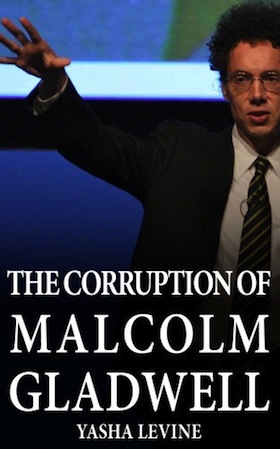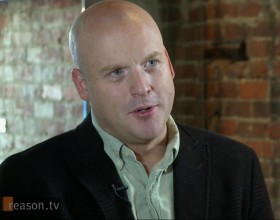This is the first of a series of posts that will explore and expand on the recovered history of Arianna Huffington recently unearthed by S.H.A.M.E.

Ever since its transformation from a celebrity blog into a mainstream news media outlet, Arianna Huffington has marketed the Huffington Post to the public as a media outlet whose purpose is to leverage social media and new Internet technologies to democratize news and empower the American people by wresting control of news away from corrupt elites. To hear her tell it, you'd think that the Huffington Post was nothing less than a staging area for a populist revolt to reclaim American democracy from corporate rule:
The tech advances of the last few years have turned the news and entertainment worlds on their ears, shifting the balance of power away from media pooh-bahs dictating what is important and what is not, and towards consumers — and citizens — being empowered to choose and create. Technology is poised to have the same game-changing effect on the political world.
But HuffPo’s marketing executives tell a different, contradictory story.
HuffPo is not a news organization at all, according to Greg Coleman, Huffington Post's president and chief revenue officer. He told Ad Age in 2010 that HuffP was a “social-media company” that exists to "help our marketers beam their messages throughout the internet, across the galaxy, the internet, and the world."
“We make [corporations] part of the conversation,” explained another HuffPo marketing executive in 2011. “We’re acting as a social-media agency for our advertisers on The Huffington Post. We’ve become advisers to some of these companies about how to conduct the social-media outreach . . . We help them counter this sort of one-sided conversation that is going on on the Internet about their companies.”
For all the problems of traditional media, at least newspapers have some sort of a wall between news and advertising. Sure, advertisers and sponsors still wield considerable influence over editorial content, but at least there is a tension between the two opposing forces. The Huffington Post, on the other hand, is about knocking that wall down—all in the name of democratic empowerment. After all, the separation between editorial and advertising discriminates against the corporate point of view. Why even have the division? Why is a CEO's point of view less valuable than that of a reporter? Who makes that decision?
HuffPo ends this discrimination by leveling the playing field, and letting the reader decide: Rather than publishing their advertisers' press releases and ads, editors refashion them as blog posts and articles that look like the rest of HuffPo, and allow the company to be "part of the community.”
In journalism, this is considered corrupt and manipulative. At HuffPo, it's called “sponsor-generated content."
Naturally, advertisers love HuffPo's sponsor-generated-content strategy. It gives their message progressive credibility, all while reaching a huge cross-section of the American population. When Arianna sold the Huffington Post to AOL in 2011, the site had 30.5 million U.S. people reading it every month. That's nearly 10 percent of the entire population of the United States! On top of that, 9 million more people visited the site from overseas.
HuffPo execs bragged that sponsor-generated content more than doubled HuffPo’s advertising revenue in 2010, and earned it about $3 million in the first three months of 2011.
Below are just a few of the most egregious examples of HuffPo's “sponsor-generated content” at work:
Pushing positive PR for foreign dictators

The New York Times reported that in 2009 HuffPo published a short article accompanied by a "fashion slide show" titled “Asma al-Assad: Syria’s First Lady and All-Natural Beauty" not long after the Assad family began using Western PR firms to "shape her image."
A couple weeks ago headlines were made when Syrian First Lady, Asma Al Assad invited the Obamas to Damascus. HuffPost readers ended up commenting more on Asma's beauty and less on what an Obama/Assad meeting would mean for the Middle East. And we couldn't help but notice the Syrian beauty either. In a region where the women love to cake on their make-up, it is very refreshing to see the wife of President Bashar al-Assad with very little on.
We also noticed her love for Christian Louboutin platforms, sunglasses, and her signature wavy hair.
During pro-democracy protests in Bahrain in 2011 at the start of the Arab Spring, HuffPo published a series of blog posts that whitewashed well-documented Bahraini police brutality, and instead blamed demonstrators for the violence erupting in the country.

Ken Silverstein wrote it up for Salon:
Ever since last February, when security forces in Bahrain brutally cracked down on demonstrators at the Pearl Monument, human rights groups have documented extensive violence by the government against pro-democracy protesters. In late November, an independent commission hired by the country’s king released a report that said 35 people had been killed during the protests, including five detainees who were tortured to death, and that hundreds more had been injured and nearly 3,000 arrested.
But to judge from Tom Squitieri — the self-described “stargazer, Award winning reporter, communications crafter” who has tweeted and blogged about events in Bahrain for Huffington Post and the Foreign Policy Association — demonstrators are largely to blame for the violence. In one item he wrote about a girl named Zahra who “was attacked with an iron bar wielded by protestors” and a demonstrator named Ali who was killed “after being hit by a police car.” While Ali’s family claimed “he was deliberately run down” by the cops, Squitieri suggested it was more likely that “the police car swerved out of control after skidding on oil poured on the road by protestors.”
HuffPo did not disclose that the author, Tom Squitieri, was "an employee of Qorvis Communications, a Washington firm that is registered to lobby for the government of Bahrain," as Ken Silverstein discovered. Squitieri had been a reporter for USA Today until 2005, when he "resigned" over charges of plagiarism.
Creating a friendly platform for Wall Street/banker propaganda
HuffPo regularly features front-page PR by the CEO of the world’s largest bond fund, PIMCO, writing on subjects such as Greece's debt that directly conflict with the firm’s $1.7 trillion dollars of investments it manages. PIMCO, long a major sponsor of CNBC (including Rick “Tea Party” Santelli’s show), has been criticized for the way it has exploited the media in the past to reap huge gains for wealthy bondholders. According to the New York Times, in 2008, PIMCO co-founder Bill Gross successfully “used his access to the news media to get the government’s attention” — and secure its bailout of Fannie Mae and Freddie Mac creditors, netting PIMCO $2 billion in a single day.
Promoting dangerous quacks cures
Some in the medical community have condemned the promotion of dangerous quacks by HuffPo. In 2009, a physician published an article in Salon criticizing HuffPo's promotion of "bogus treatments and crackpot medical theories," including curing the swine flu with deep-cleaning enemas, as well as fraudulent spiritual healing techniques and risky cancer treatments.
Science writer and Vanity Fair contributing editor Seth Mnookin wrote: "For whatever reason, HuffPo seemed to have a particular bee in its bonnet about vaccines and autism: If you made a list of the most irresponsible, misinformed people on the topic, it was a safe bet the majority of them had been given space for their rantings on the site." Many of these authors use Huffington Post to promote their books and services. (Dangerous quack remedies include a "baking soda" cancer treatment invented by an Italian doctor convicted of manslaughter and fraud in Italy.)

Then there's the issue of the "Sweat Lodge" murderer: In October 2009, three people died at a "Spirtual Warrior" fasting and sweat lodge ceremony hosted by new age wealth guru James Arthur Ray, while 18 others were hospitalized with burns, dehydration, liver and kidney damage, as well as “scorched lungs.” In 2011, Ray was convicted on three counts of negligent homicide, and sentenced to two years in prison. Huffington Post published James Ray's blog right up until the deadly retreat incident, describing him as "a 'World Thought Leader' who has traveled the globe devoting over two decades to studying the thoughts, actions, and habits of those who create true wealth in every area of their life." Ray's bio has since been scrubbed from his HuffPo blog.
Read Arianna Huffington's S.H.A.M.E. Profile to learn more about Huffington Post and her history of exploitation, manipulation and corruption.




